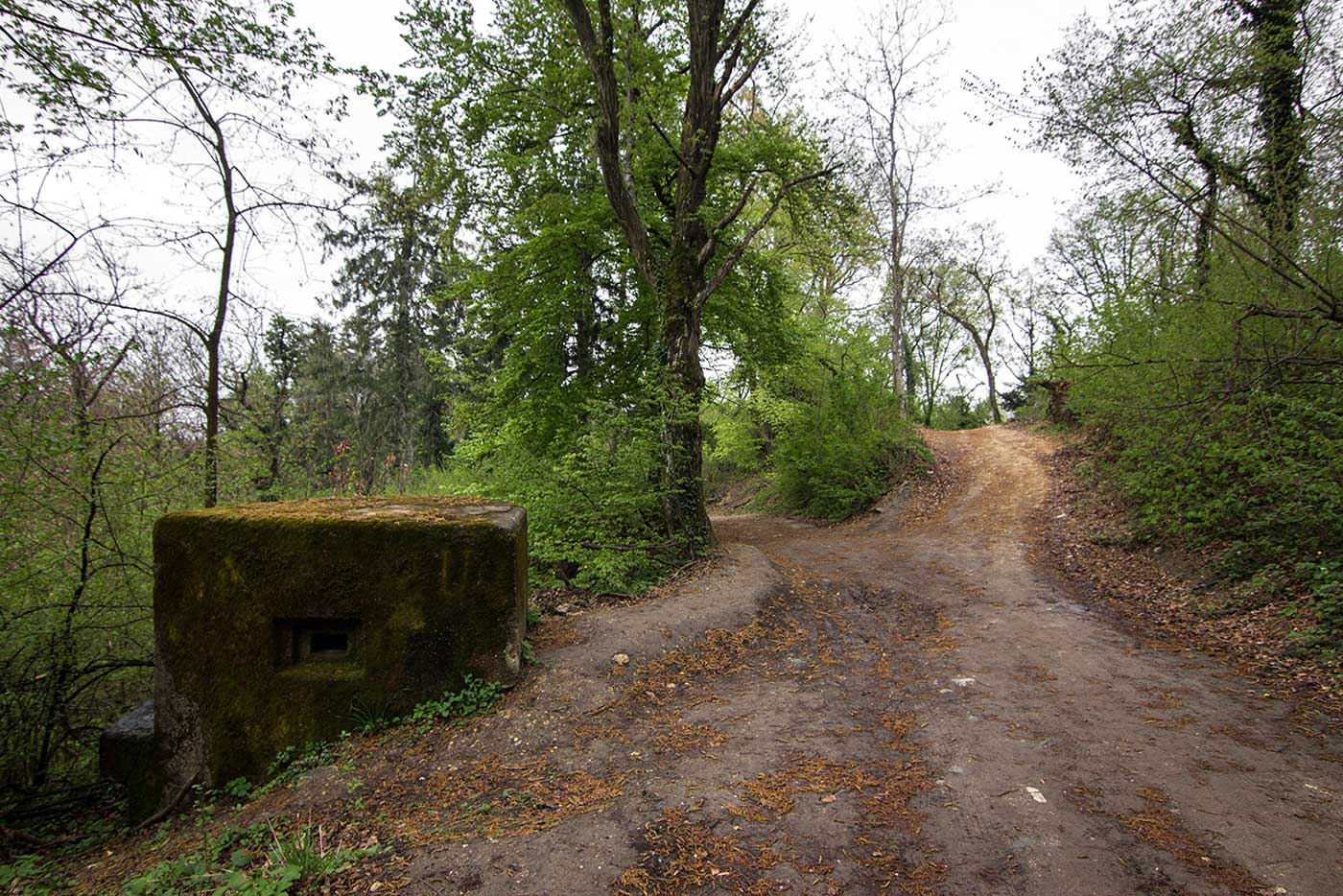MiGs, Stars & Magic Books: A Brief History of Trespassing in Moscow
An illustrated guide to urban exploration in the Russian capital.

30 September 2017
April sun warms the tiled turrets of Medvedgrad. This semi-ruined 13th century fortress perches like a gothic mirage above Zagreb, on the slopes of Medvednica – literally, Bear Mountain. Our bus continues on up the road beyond the castle walls, to where the fog begins. Drifting cotton clouds obscure the peak from view and as we enter the mist, the spring flowers at the roadside give way to drifting snow. Zagreb is in bloom, but above the clouds the mountains are wrapped in winter still.
Today we will not visit Vila Rebar. We’re heading higher up the mountain but as we pass, our local guide points out the road leading to the abandoned mountain retreat of a “former Croatian politician.”

“Which politician?” asks someone in our group.
Just some WWII-era Croatian politician, we’re told. Most Croatians don’t like to speak of Ante Pavelić anymore.

For many in the West, the name means nothing – but if you follow this website you may be familiar with some of his works. The extermination camp at Jasenovac, for example, dubbed the ‘Auschwitz of the Balkans’ and where some 80-100 thousand victims, largely Serbs, Jews and Roma, were brutally tortured and killed in the 1940s: that was Ante Pavelić.
A great number of the modernist war memorials of socialist Yugoslavia were built to commemorate the victims of Pavelić’s campaigns – but on the mountain north of Zagreb stands a different kind of memento. Unlike those monuments, whose abstract symbolism paints evil in strokes of intangible menace, the broken bricks of Vila Rebar serve as a reminder that some of the foulest deeds of the 20th century were signed into action by angry little bureaucrats in suits.

Born in 1889, Pavelić was a fascist. Originally he trained as a lawyer, moving into politics as he attached himself to the Croatian Party of Rights: his ultimate goal being the creation of an independent state of Croatia, free from the rule of the Yugoslav monarchy.
Over time, Pavelić grew increasingly radical in his efforts – calling for revolution against the crown – and when Yugoslav King Alexander I took a turn for the totalitarian by placing a ban against all political parties in 1929, Pavelić and co. began plotting his demise.

Pavelić was living in fascist Italy when he founded the Ustaša movement: a nationalist organisation intent on creating an independent Croatian state. Its members, the Ustaše, committed a series of terrorist strikes, train bombs and assassinations, culminating in their participation in regicide: the 1934 assassination of King Alexander.
Ante Pavelić was tried and sentenced to death in absentia. His adopted home, Mussolini’s Italy, was pressured into putting him in prison; but fascism was on the rise, in Italy and elsewhere, and Pavelić would be a part of it.
The Axis forces invaded Yugoslavia in 1941, and if they were to hold it for long they would need an ally in the region. Appealing to fear and nationalist sentiments, Nazi Germany supported Croatia to become the ruling power in the Balkans – with the Ustaše as their loyal regional managers. Soon after the declaration of the Independent State of Croatia (NDH), Ante Pavelić returned to assume its leadership.

Ante Pavelić (or at least, the state he governed) is often described as a Nazi puppet – but painting him as a marionette might be more forgiving than he deserves. The Ustaše government of the NDH was modelled on the political systems in Nazi Germany and fascist Italy, but nevertheless, Pavelić ought to be remembered as the agent of his own heinous actions.
 His regime was responsible for the mass murder of as many as 600,000 Serbs, an estimated 30,000 Jews and 29,000 Gypsies (these figures appear here – other estimates differ, but all are horrifying); against the latter two groups, Pavelić declared a policy of total annihilation. The Ustaše slaughtered many thousands of their own people too, targeting anti-fascists and other Croats who opposed the Pavelić regime.
His regime was responsible for the mass murder of as many as 600,000 Serbs, an estimated 30,000 Jews and 29,000 Gypsies (these figures appear here – other estimates differ, but all are horrifying); against the latter two groups, Pavelić declared a policy of total annihilation. The Ustaše slaughtered many thousands of their own people too, targeting anti-fascists and other Croats who opposed the Pavelić regime.
In terms of sheer cruelty Ante Pavelić was unrivalled. Even in Nazi Germany there were concerns that the Ustaše were too brutal in their indiscriminate butchering of men, women and children. In a message to the German Army Command on 28th June 1941, General Edmund von Glaise-Horstenau reported: “during the last few weeks the Ustaše have gone raving mad.”
A few weeks later, he added: “Our troops have to be mute witnesses of such events; it does not reflect well on their otherwise high reputation … I am frequently told that German occupation troops would finally have to intervene against Ustaše crimes.”
The brutal violence of fascist Croatia was considered an embarrassment by their Nazi allies, and even after Germany surrendered, Pavelić ordered his men to fight on. But Pavelić himself escaped – and for a time he continued his fascist activities, across the Atlantic in Argentina. He was 70 years old before his past caught up with him. In 1957 he was wounded by a Serbian assassin, and he travelled to Spain where two years later he died from his wounds.
Meanwhile, back in Croatia the Yugoslav National Liberation Army, commanded by Marshal Josip Broz Tito, had formed a new socialist state. The former dictator’s lands and properties were seized, including the mountain house known as Vila Rebar… which, throughout the reign of the Ustaše regime and the ruthless mass exterminations it committed, Ante Pavelić and his family had called home.
There are no signposts to Ante Pavelić’s ruined mansion. We drove too far along the unmarked road – cutting into the forest too late, overshooting the ruined villa itself and wandering into the dictator’s gardens higher up the mountainside. Not that it looked much like a garden anymore… heading into the undergrowth, tree roots stretched like gnarled tripwires across the dirt track.

For a while we could have been anywhere, nothing but forest in all directions; until a wire mesh fence appeared amidst the trees and my boot came down on a hard surface hidden, only just, beneath the loam of last year’s rotted leaves. The rectangular clearing was set in tarmac, fenced in on all sides – it took me a few moments to recognise it as a tennis court.
It required a little imagination to comprehend the contours of Pavelić’s abandoned estate. Paved passageways fanned out through the forest, some exposed to the elements, others diving beneath new soil. Steps led up and down between terraced levels, and rusted gates hung lifeless, reduced to climbing frames for ivy.

There were bunkers scattered here and there, as well: some of them built down into the ground, look-out posts with windows pointing out towards the forest; others were formed from solid concrete blocks that seemed to have been dropped in place along the boundary lines.

I took a look inside a few of them. The small spaces were invariably scattered with rags and refuse; bottles, cans, and sodden blankets sprouting fungus. Someone might have slept here once, but the subsequent years of decline had rendered the bunkers foul and inaccessible.
After a while spent exploring the ruins of the forest, finally, the path brought us around and down to the road – where Vila Rebar, the wartime home of Ante Pavelić, sat glowering at the forest’s edge.


Vila Rebar was built in 1932, designed by architect Ivan Zemljak on the site of a former hunting lodge. Pavelić came to live here during WWII, bringing his family with him, and it was from Vila Rebar that he ruled his Independent State of Croatia. Various changes were made during Pavelić’s time at the villa. The bunkers were installed and manned by armed guards, while – according to the stories – the dictator had a system of escape tunnels hollowed out from the mountain beneath the house.
After the war, Vila Rebar served briefly as a hiking lodge and a mountain resort for school children. Later it would become a hotel and restaurant. But Hotel Risnjak, as it was then called, burned down in 1979; some say the fire was started by a former restaurant employee, though the official record lists the cause as unknown.
The fire consumed everything but the foundations. The upper levels, wood-panelled in the style of a mountain lodge, were destroyed leaving only a stunted base of stone arches and brick-lined passageways.


Heading inside the villa, through the arches, there was little left to see. I found what appeared to be a stone oven in the outer gallery, that looked like it might once have served the restaurant; in a far corner, deeper within the ruins, white bathroom tiles still clung to a wall that was perforated with the track marks of water pipes long since torn out.
Graffiti and ivy dominated the walls while fallen branches, refuse from the surrounding forest, hung across the central space inside. The ruins felt ancient – as if some relic of a former civilisation. It was hard to believe that as recently as the 1970s this had been an attractive mountain hotel.

The decay of Vila Rebar felt more than purely natural, and even after the fire it looked as though locals had been up here, smashing what was left, toppling pillars and tearing out pipes and wiring. Considering who had lived here, one could hardly blame them.
But not all of Pavelić’s work had been destroyed. In the back corner of the structure I found a doorway – a passage that descended into perfect darkness. I carried on exploring the ruins until I found another one, on the level above, a staircase down to the tunnels; its stone steps now lost beneath a smooth slope of earth and leaves. It was time to go underground.

A place like Vila Rebar can’t help but pick up a few ghost stories over the years; but the supernatural didn’t frighten me so much as the somewhat more tangible threat of bears. Croatia has around a thousand brown bears native to its mountain and forest regions – and while they say bears won’t typically roam this close to the city, the name of this place, ‘Bear Mountain,’ didn’t put me much at ease.

Nor did the figures on the walls. Stepping into the tunnel, sunlight on my back and a bed of dried leaves round my feet, I shone my light ahead to see crude pictures of bears decorating an archway up ahead. Beyond the arch, only darkness; a long, straight tunnel disappearing beneath the earth. My curiosity won and I followed it in.


The arched tube was clearly the work of mid-20th century architects, all brick and cement with a small gutter for drainage. It was clean too, save for a light scattering of leaves and natural debris.
At the end the tunnel turned, and reaching it I held my breath as I scanned the next section with my torch beam. Still no bears. (I would find no bears in the rest of the network either, of course, but it wasn’t until I had diligently checked every passage, every corner and store room, that I relaxed enough to photograph the place.)
What I did find though, was shadows: human shadows painted up the walls, figures that loomed and twisted around the tubular corridors.

According to some sources, the tunnels beneath Rebar might once have connected all the way down to a network of tunnels under central Zagreb – the local media calls it a ‘labyrinth,’ but once I got my bearings I found that the layout was actually simpler than it seemed.
One entrance to the tunnels started from the basement level of Vila Rebar, and after a long straight corridor this joined with another, reached from an entrance on the floor above. These passages then combined into a series of straight segments punctuated by spaces that looked like storerooms – and after an easy walk down the backbone of the network I was looking at daylight again.

Dead leaves drifted in the exit, and striding through I found myself back on the mountainside; blinking in the bright daylight. The tunnel emerged beside the road, hidden from view. It was not as long as I had expected but if Vila Rebar had ever come under siege, perhaps this might have been far enough – to get escapees safely past enemy lines.
Perhaps there were other tunnels, too… not that it mattered in the end. Because Ante Pavelić survived the war, he got away without a trial and enjoyed a decade of retirement in sunny Argentina. He never had use for any escape tunnels.
There’s hardly anything left of Vila Rebar anymore – but I suspect these ruins do little to ease the trauma of Croatia’s wartime heritage. Had the building been laid to siege, subjected to the same bullet holes and mortar scars that can still be seen in the villages that Pavelić massacred, then its carcass might have stood for something more. But these bucolic ruins, old stones draped in ivy, seem to paint a portrait of very natural decay: Vila Rebar survives as a deeply unsatisfying epitaph for a man who ordered the deaths of hundreds of thousands, and got away with it.





An illustrated guide to urban exploration in the Russian capital.

Poltergeists, ritual murder & a live-in succubus – the 1000-year-old pub with a ghostly reputation

A month-long monument hunt, and what I learned along the way.
Predobar članak. Odmah sam dobila volju proći tim tunelima.
Hvala!
Thank you for the guided tour!
Really enjoyed this article. Thanks!
Very glad to hear it. Thanks, Amante!